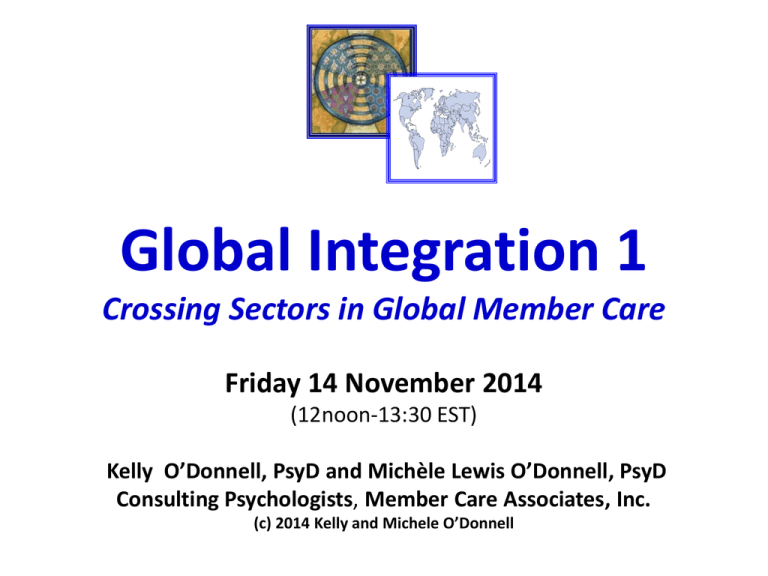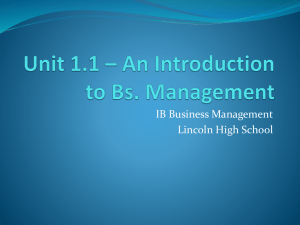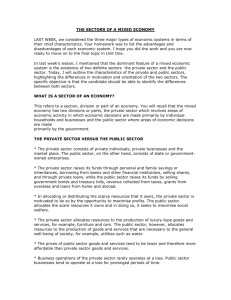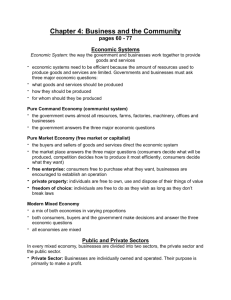Click here for the powerpoint (60 slides
advertisement

Global Integration 1 Crossing Sectors in Global Member Care Friday 14 November 2014 (12noon-13:30 EST) Kelly O’Donnell, PsyD and Michèle Lewis O’Donnell, PsyD Consulting Psychologists, Member Care Associates, Inc. (c) 2014 Kelly and Michele O’Donnell Four GI Topics • • • • United Nations (perspectives) Member Care (global model) Crossing Sectors (strategies and examples) Sustainable Development (proposed goals) Two main sources: --Global Member Care (volume 2): Crossing Sectors for Serving Humanity (Introduction and chapter 2) -- MCA Resource Update, November 2014—Sustainable Development Note to access core materials: • The Introduction (Growing Broadly in Mission/Aid--and Beyond) and Chapter 2 (Charting Your Course Through the Sectors) in our edited book, Global Member Care (vol 2): Crossing Sectors for Serving Humanity. You can access these materials via the Amazon ebook preview (click on the book cover that you see): http://www.amazon.com/GlobalMember-Care-Crossing-Humanity-ebook/dp/B00HX6WZLQ • 2. Review the list of the Sustainable Development Goals in our November 2014 MCA Resource Update: http://us4.campaignarchive2.com/?u=f34fc856e7776d7b69dafd3b3&id=d73606 536a Human Resource Sector TOC (examples) • Chapter 29: Managing and Supporting Staff People In Aid • Chapter 30: Staff Care in Organizations InterHealth and People In Aid • Chapter 31: Resilience, Risk, and Responsibility International Federation of Red Cross/Red Crescent Societies • Chapter 32: Organizational Culture: Staff Wellbeing/Effectiveness United Nations High Commissioner for Refugees • Chapter 33: Humans Abusing Humans: Smuggling, Trafficking, Abduction United Nations High Commissioner for Refugees To access the website for the GMC bookseries: https://sites.google.com/site/globalmca/ Global Integration (GI) Connecting relationally and contributing relevantly on behalf of the core issues facing humanity and in light of our core values.* 4core *and making a living… Part 1 United Nations A context for charting your GI course • • • • The United Nations is a 20th-century organization facing a 21st-century challenge as an institution with impressive achievements but also haunting failures, one that mirrors not just the world’s hopes but its inequalities and disagreements, and most important, one that has changed but needs to change further…. The single greatest problem facing the United Nations is that there is no single greatest problem; rather there are a dozen different ones each day clamoring for attention. Some, like the crisis in Lebanon, the Palestinian situation and the nuclear programs in Iran and North Korea, are obvious and trying. Others we call “problems without passports”— issues that cross all frontiers uninvited, like climate change, drug trafficking, human rights, terrorism, epidemic diseases, and refugee movements. Their solutions, too, can recognize no frontiers because no one country or group of countries, however rich or powerful, can tackle them alone. Shashi Tharoor, The Good for Something United Nations, Newsweek, September 4, 2006 UN Charter, 1945 • • • • We the peoples of the United Nations determined: to save succeeding generations from the scourge of war, which twice in our lifetime has brought untold sorrow to mankind, and to reaffirm faith in fundamental human rights, in the dignity and worth of the human person, in the equal rights of men and women and of nations large and small, and to establish conditions under which justice and respect for the obligations arising from treaties and other sources of international law can be maintained, and to promote social progress and better standards of life in larger freedom… More Perspectives: The United Nations • But the world is not so happy a place. Billions of people suffer impoverishment, many until the end of their miserable lives… • Can we really offer justice and freedom from want to a mid-twentyfirst-century earth of perhaps nine billion people, one-third of whom may live in squalor and desperation?... • [Surprises and setbacks] should not deter us from responding as best we can, using our talents to improve this always mixed record of trying “to save generations from the scourge of war,” “to reaffirm faith in fundamental human rights,” and “to promote social progress and better standards of life in larger freedom.” • The original Preamble to the Charter of the United Nations had it right. The question is, can we do it? (Paul Kennedy, The Parliament of Man: The Past, Present, and Future of the United Nations, 2006, 279, 289) Part 2 Member Care Reviewing the new global model MC defined: Providing and developing resources to support the wellbeing and effectiveness of international/national/local staff and their sending organisations. [and those not “sent” by an organization] Network Connections 5. NETWORK CARE Catalyze, Consult, Connect 3. SENDER CARE 2. SELF CARE 1. MASTER CARE K y/M MUTUAL CARE Expatriates & Nationals ConCrisis ting / enc y © 2000 Kelly O’Donnell and Dave Pollock ed ica ica l/ l / lingcal e s gi un Co cholo y Ps Fin Log anci isti al/ cal il Fam Recruitment - Retirement 4. SPECIALIST Ph CARE M ys / ing uild nal m B rso Tea rpe e Int All Mission Personnel T ra in Car ing/ eer l/ ra to ual s Pa pirit S Specialist Caregivers Sender Commitment Self/Mutual Core/Community Master Christ Five Good Practice Flows Sphere 1. Master Care: Good Practice Principle 1—Flow of Christ Our relationship with Christ is fundamental to our well-being and work effectiveness. Member care resources strengthen our relationship to the Lord and help us to encourage others in the Lord. Sphere 2. Self and Mutual Care: Good Practice Principle 2—Flow of Community Self care is basic to good health. Self-awareness, monitoring one’s needs, a commitment to personal development, and seeking help when needed are signs of maturity. Likewise quality relationships with family and friends are necessary…with those in one’s home and host cultures. Sphere 3. Sender Care: Good Practice Principle 3—Flow of Commitment An organisation’s staff is its most important resource. As such, sending groups—both churches and agencies—are committed to work together to support and develop their personnel throughout the worker life cycle. They demonstrate this commitment by the way they invest themselves… Sphere 4. Specialist Care: Good Practice Principle 4—Flow of Caregivers Specialist care is to be done by properly qualified people, usually in conjunction with sending groups. The goal is not just care, but empowerment—to help personnel develop the resiliency and capacities needed to sacrifice and minister to others. Sphere 5. Network Care: Good Practice Principle 5—Flow of Connections Member care providers are committed to relate and work together, stay updated on events and developments, and share consolidated learning from their member care practice. They are involved in not just providing their services, but in actively “knitting a net” to link resources with areas of need. • . Add new model Relevance of Sectors Sphere 6 for MC • Humanitarian Sector: relevant in the common commitment for supporting and managing international and local staff, in maintaining effective organizations, and in offering a variety of relief and development services to vulnerable populations. • Human Health Sector: relevant in the common commitment to promote human wellness through research, resources, advocacy, and policies at all levels of society, and applicable to staff and those with whom staff work. • Human Resource Sector: relevant in the common commitment to fulfill organizational objectives by developing and managing human resource systems and by promoting staff/volunteer well-being and effectiveness (with some emphasis on organizational development). Sector Care: Good Practice Principle 6: Flow of Common Ground • People with member care responsibility in mission/aid stay in touch with sectors that are relevant for their work. They are willing to cross into new areas—emphases, projects, disciplines, and fields within related sectors—for mutual learning, exchanging resources, and developing skills. Crossing sectors includes a continuum of involvement which is carefully considered in view of one’s primary focus in member care: being informed by, integrating with, and/or immersing in a given sector or part of a sector. Mt. 13: 52 • “Therefore every scribe that has become a disciple of the kingdom of heaven is like the owner of the house that brings from his treasure new things and old things” • Our application: Every learned/influential person who is a serious follower of God and God’s ways, is a steward of important resources—she/he is aware of and utilizes foundational (old) and new resources that are special/crucial: perspectives, practices, tools, relationships , directions, etc. ad majorem Dei gloriam. Global MC Course • See the MCA Resource Update, September 2014, for the syllabus of the Global Member Care Course. The course now includes chapters from the Crossing Sectors book along with the missio Dei theological perspective In the Resource Updates section at: www.membercareassociates.org 100 + Books for a MC Library See the list at: www.membercareassociates.org Applications: • To support mission/aid workers in their wellbeing and effectiveness • To support colleagues in other sectors via materials in the member care field • To equip mission/aid workers with tools and opportunities for their work with others • To equip member caregivers who directly work with vulnerable populations and others • To stay informed as global citizens about current and crucial issues facing humanity Part 3 Crossing Sectors Going broadly and growing deeply • “Mathematically, a sector is the area of a circle bounded by any two radii. (Think of a sector as being a triangular piece of pie cut from the midpoint of a round pie.) • From this geometric definition emerges the concept of human sectors, or specialized groupings of people. For our purposes a sector is a distinct part of society (analogous to the area between two radii in a circle or a piece of pie) with a special albeit broad purpose. It is a large, amorphous yet recognizable block within the international community that provides different types of services and products to people. • Each one is comprised of a wide array of people who are part of different organizations; influenced by various disciplines, practices, and goals; and intertwined with many related networks. A sector fundamentally, is a human entity.” Crossing Sectors for Serving Humanity, p.p. 5-6 Example: The Humanitarian Sector • “The humanitarian sector includes thousands of nongovernmental organizations, government and intergovernmental agencies, and groups from civil society including faith-based groups. These entities provide a myriad of worthwhile services such as medical care, military and civilian peacekeeping in conflict zones, relief response in natural disasters, human rights advocacy, HIV/AIDS prevention, childhood education, maternal health care, water purification, and so many other areas. Collectively they represent much of humanity’s concerted effort to alleviate human misery and promote human wellbeing.“ Crossing Sectors for Serving Humanity, p. 6 Relevance… • “The relevance of crossing sectors is clearly seen in the research by Johnson et al (2010) which advocates for greater interactions between the major religious blocs, especially Christians and non-Christians, in the service of humanity. [Quote:] • What percentage of non-Christians personally know a Christian?…The [research] results are startling in the sense that Christians and non-Christians appear to be living in quite separate worlds. This distance has implications for Christian missions but is also problematic when it comes to dialogue, peace initiatives, environmental and health challenges, and many other areas of human interaction. Our hope is that highlighting the problem will help in planning solutions for the future. (p.29)” • Crossing Sectors, p.p. 9-10 Relevance… • “We think that intentionally crossing sectors is the next developmental phase for the member care field. • What are some resources/practices and challenges/problems within these sectors? • What can we learn from each other? • How can our experiences in these sectors help us improve our member care efforts for supporting and managing mission/aid staff? • We are entering into some new terrain while at the same time solidly building on the field’s foundations and core focus on mission/aid workers. In so doing we seek to broaden and further shape the contours of good practice in member care. “ • Crossing Sectors for Serving Humanity Crossing sectors: a. Issues Pursue your passions What issues matter to you the most? What are you passionate about? What are you naturally motivated to learn more about? Take it further by exploring what is happening in these areas within other sectors. Be prepared to expand your “experiential boundaries,” knowing that it can be a bit uncomfortable but also rewarding. It may take time and effort to significantly connect and contribute. Don’t go alone but get involved with others. Find compatible colleagues with similar interests and key groups and networks in which you can be part. Crossing sectors: b. Involvements Till the terrain What types and levels of involvement are realistic for you? Crossing sectors can be understood as a “continuum of involvement.” Informed----------Included----------Immersed The continuum begins with more minor involvement in a sector, such as reading the quarterly magazines from a human resources organization about things like staff selection and people management (informed). It then proceeds to a midpoint and the inclusion of a sector or parts of a sector in one’s work such as travel health resources for preventing road traffic accidents and malarial infections (included). The end of the continuum could involve becoming a recognized part of another sector such as working part time as a human rights advocate in a nongovernmental organization or developing culturally relevant psychosocial support for victims of gender violence (immersed). Crossing sectors: c. Influences Get a grid What has influenced your desire and ability to cross sectors? List 3-5 items for each of the six categories below. • • • • • • Principles/Beliefs Documents/Materials Organizations/Groups People/Models Milestones/Gravestones Charting a Future Course Crossing Sectors: Personal Influences Principles/ Beliefs 1. The “unity of truth” across time and subjects 2. The imago Dei as a basis for loving truth and peace 3. Moral duty and “blessed to be a blessing” 4. Resilient virtue is stronger than resilient evil 5. Human history has a direction and purpose Documents/ Materials 1. Universal Declaration of Human Rights (United Nations, 1948) 2. Doing Member Care Well (2002). Organizations/ Groups People/Models Milestones/ gravestones 1. Spanish classes and Latin America (1970–83) 2. Integration of psychology and theology doctorate (1978–84) 3. Perspectives on the World Christian Movement course (1981) 4. “We must develop a macro model for member care” (1990). Crossing sectors: Charting a future Course 1. Greater involvement in global mental health and with mental health as mission…3. Greater involvement in international affairs/international relations. Crossing sectors: d. More strategies • See the website for the Global Member Care book series (see the section with suggestions for using volume 2): https://sites.google.com/site/globalmca/ Crossing Sectors—Example 1 Humanitarian Assistance Five foundational resources that are relevant for member care See pages-12-14 in Global Member Care (vol. 2)—10 examples of lessons learned . IFRC • In the aftermath of a number of disasters in the early 1990s, the necessity and importance of addressing the psychological needs of victims were amply demonstrated. This led to the establishment of the psychological support programme (PSP) of the International Federation in May 1991…. • However, a series of conflict situations brought to light another category of people psychologically affected by disasters: relief workers. Many Red Cross and Red Crescent delegates who had worked in relief operations (Rwanda and Somalia, for example) came back feeling lost, isolated, depressed and completely exhausted and suffering from nightmares and flashbacks. They often found it difficult to talk about their feelings of helplessness and horror to family, friends and colleagues who could not fully understand what they had been through or were not interested. • It became increasingly apparent, therefore, that delegates needed specialized psychological debriefings. (Psychological Support Programme for Delegates, Psychological Support: Best Practices from Red Cross and Red Crescent Programmes, 2001, p. 18). . The ‘invisible shield’ of protection disappears • “…the world community looked forward to an era of greater personal freedom and social progress. • …[but] superpower stalemate was replaced by a series of nasty ethnic, religious and other conflicts. • …Civilians became deliberate targets of terror or human pawns in the political endgame • ….safety was not a ‘luxury’ but a necessary part of continuing the business of saving lives • …Refugees are most in need of assistance at the very same moment when relief officials are most exposed to personal danger.” . Short Questionnaire on Stress Based on: “Relief Worker Burnout Questionnaire” in Coping with Disaster (1999) by John H. Ehrenreich • • • • • • • • • • • • • • • • • • Instructions: Rate the following items in terms of how much the symptom was true of you the last month. 0 = Never 1 = Occasionally 2 = Somewhat often 3 = Frequently 4 = Almost always ***** ___1. Do you tire easily? Do you feel fatigued a lot of the time, even when you have gotten enough sleep? ___2. Are people annoying you by their demands and stories about their daily activities? Do minor inconveniences make you irritable or impatient? ___3. Do you feel increasingly critical, cynical or disenchanted? ___4. Are you affected by sadness you can’t explain? Are you crying more than usual? ___5. Are you forgetting appointments, deadlines, personal possessions? Have you become absentminded? ___6. Are you seeing close friends and family members less frequently? Do you find yourself wanting to be alone and avoiding even your close friends? ___7. Does doing even routine things seem like an effort? ___8. Are you suffering from physical complaints such as stomach aches, headaches, lingering colds, general aches and pains? ___9. Do you feel confused or disoriented when the activity of the day stops? ___10. Have you lost interest in activities that you previously were interested in or even enjoyed? ___11. Do you have little enthusiasm for your work? Do you feel negative, futile, or depressed about your work? ___12. Are you less efficient than you think you should be? ___13. Are you eating more (or less), smoking more cigarettes, using more alcohol or drugs to cope with your work? Total Score: (Add up scores for items 1-13) People are central to the achievement of our mission. (Guiding Principle, PIA ) • • Principle 7: Health, Safety and Security. The security, good health, and safety of our staff are a prime responsibility of our organization. Written policies are available to staff on security, individual health, care and support, health and safety. Program plans include written assessment of security, travel and health risks specific to the country or region, reviewed at appropriate intervals. Before an international assignment, all staff receive health clearance. In addition, they and accompanying dependents receive verbal and written briefing on all risks relevant to the role to be undertaken, and the measures in place to mitigate those risks, including insurance… Briefings are updated when new equipment, procedures, or risks are identified. All staff have a debriefing or exit interview at the end of any contract or assignment. Health checks, personal counseling, and careers advice are available. Managers are trained to ensure these services are provided. . . “…the most stressful events in humanitarian work have to do with the organisational culture, management style and operational objectives of an NGO or agency rather than external security risks or poor environmental factors. Aid workers, basically, have a pretty shrewd idea what they are getting into when they enter this career, and dirty clothes, gunshots at night and lack of electricity do not surprise them. Intra-and inter-agency politics, inconsistent management styles, lack of team work and unclear or conflicting organizational objectives, however, combine to create a background of chronic stress and pressure that over time wears people down and can lead to burnout and even physical collapse.” John Fawcett, Stress and Trauma Handbook: Strategies for Flourishing in Demanding Environments (2003, World Vision, p. 6). Crossing Sectors—Example 2 Global Mental Health (5 resources) GMH is an international, interdisciplinary, and multisectoral domain which promotes human well-being, the right to health, and equity in health for all. It encourages healthy behaviours and lifestyles; is committed to preventing and treating mental, neurological, and substance use conditions; and seeks to improve policies and programs, professional practices and research, advocacy and awareness, and social and environmental factors that affect health and well-being." (GMH--Finding Your Niches and Networks, Psychology International, March 2012) See also our GMH-Map website: Global Mental Health: A Global Map for a Global Movement Hidden Pictures : A Personal Journey into GMH Feature GMH film http://www.hiddenpicturesfilm.com/ (two minute trailer) Who is hiding? Who is hurting? Who is helping? World Mental Health Day (1992-2014, 10 October) • • • • • • • • • • • • • • • • • • • • • • 2014: Living with Schizophrenia 2013: Mental Health and Older Adults--Note: Hidden Pictures (feature film) 2012: Depression--Note: I Had a Black Dog (self-help animation, five minutes) 2011: The Great Push: Investing in Mental Health 2010: Mental Health and Chronic Physical Illnesses 2009: Mental Health in Primary Care 2008: Making Mental Health a Global Priority: Advocacy/Action 2007: Mental Health in a Changing World: Culture and Diversity 2006: Building Awareness–Reducing Risk: Mental Illness/Suicide 2005: Mental and Physical Health Across the Life Span 2004: The Relationship between Physical and Mental Health 2003: Emotional/Behavioral Disorders of Children/Adolescents 2002: The Effects of Trauma/Violence on Children /Adolescents 2001: Mental Health and Work 2000: Mental Health and Work 1999: Mental Health and Ageing 1998: Mental Health and Human Rights 1997: Children and Mental Health 1996: Women and Mental Health 1995: Mental Health and Youth 1994: Improving Mental Health Services throughout the World 1992-1993 (general themes) , Global Mental Health Evidence-Based Practice in Low Resource Countries 10 October 2013, Geneva [Note: you can access the powerpoint/traing docs here: http://ngo-forum-health.ch/mental-health/training/] WHO Collaborating Centre on Mental Health of the University of Geneva, Department of Psychiatry Overview: Mental Health Action Plan 2013-2020 Vision A world in which mental health is valued, promoted, and protected, mental disorders are prevented and persons affected by these disorders are able to exercise the full range of human rights and to access high-quality, culturally appropriate health and social care in a timely way to promote recovery, all in order to attain the highest possible level of health and participate fully in society and at work free from stigmatization and discrimination. Cross-cutting Principles Universal health coverage Human rights Evidence-based practice Life course approach Multisectoral approach Regardless of age, sex, socioeconomic status, race, ethnicity or sexual orientation, and following the principle of equity, persons with mental disorders should be able to access, without the risk of impoverishing themselves, essential health and social services that enable them to achieve recovery and the highest attainable standard of health. Mental health strategies, actions and interventions for treatment, prevention and promotion must be compliant with the Convention on the Rights of Persons with Disabilities and other international and regional human rights instruments. Mental health strategies and interventions for treatment, prevention and promotion need to be based on scientific evidence and/or best practice, taking cultural considerations into account. Policies, plans, and services for mental health need to take account of health and social needs at all stages of the life course, including infancy, childhood, adolescence, adulthood and older age. A comprehensive and coordinated response for mental health requires partnership with multiple public sectors such as health, education, employment, judicial, housing, social and other relevant sectors as well as the private sector, as appropriate to the country situation. Empowerment of persons with mental disorders and psychosocial disabilities Persons with mental disorders and psychosocial disabilities should be empowered and involved in mental health advocacy, policy, planning, legislation, service provision, monitoring, research and evaluation. Goal To promote mental well-being, prevent mental disorders, provide care, enhance recovery, promote human rights and reduce the mortality, morbidity and disability for persons with mental disorders Objectives and Targets 1. To strengthen effective leadership and governance for mental health Global target 1.1: 80% of countries will have developed or updated their policy/plan for mental health in line with international and regional human rights instruments (by the year 2020). Global target 1.2: 50% of countries will have developed or updated their law for mental health in line with international and regional human rights instruments (by the year 2020). 2. To provide comprehensive, integrated and responsive mental health and social care services in community-based settings Global target 2: Service coverage for severe mental disorders will have increased by 20% (by the year 2020). 3. To implement strategies for promotion and prevention in mental health Global target 3.1: 80% of countries will have at least two functioning national, multisectoral mental health promotion and prevention programmes (by the year 2020). Global target 3.2: The rate of suicide in countries will be reduced by 10% (by the year 2020). 4. To strengthen information systems, evidence and research for mental health Global target 4: 80% of countries will be routinely collecting and reporting at least a core set of mental health indicators every two years through their national health and social information systems (by the year 2020). Part 4 Sustainable Development Building the future we want We are right in the middle, as the world community and spearheaded by the United Nations, of formalizing the Post 2015 Agenda for sustainable development. What will be the goals, targets, and indicators that will be agreed upon in late 2015 and which will take us to 2030? The recent Open Working Groups Outcome Document from July 2014 is the main reference point for the Sustainable Development Goals (SDGs) that are emerging. This important document builds upon many previous efforts, especially the lessons learned from the Millennium Development Goals (2002-current) and the commitments made in the Rio +20 Declaration on Sustainable Development: The Future We Want (June 2012, available in six languages). More resources for equipping people with relevant mental health skills (member care and mission/aid workers) • 1. See the lists in the October 2014 MCA Resource Update (Creative Tools for Healing) Topics include: depression, grief/loss, addictions, etc.) • 2. Psychological First Aid (2011, WHO, World Vision, War Trauma Foundation—free download) • 3. For an example of how a respected Christian organization working in mental health/development presents itself publically, see HimalPartner (Norway): http://www.himalpartner.no/om-himalpartner/information-in-english Millennium Development Goals (MDGs) “In September 2000, building upon a decade of major United Nations conferences and summits, world leaders came together at United Nations Headquarters in New York to adopt the United Nations Millennium Declaration, committing their nations to a new global partnership to reduce extreme poverty and setting out a series of time-bound targets - with a deadline of 2015 - that have become known as the Millennium Development Goals.” www.un.org/millenniumgoals Question: What are the eight MDGs? End Poverty and Hunger Universal Education Gender Equality Child Health Maternal Health Combat HIV/AIDS Environmental Sustainability Global Partnership Sustainable Development Goals Central to the upcoming SDGs is the need for a coordinated, massive effort to eradicate poverty in all its forms, prioritizing both people and the planet, and doing so by integrating the SDG’s social, economic, and environmental dimensions (see also the Executive Summary in State of the Least Developed Countries 2014, focusing on poverty eradication and the SDGs). How the world community agrees upon and accomplishes the upcoming SDGs (underpinned by the desire for justice and equity for all) is still being negotiated and debated. • Review the short overview on the UN's Sustainable Development Knowledge Platform. • Review the 17 proposed SDGs and the 169 targets in the Open Working Groups Outcome Document. Proposed SDGs • • • • • • • • • • • • • • • • • Goal 1 End poverty in all its forms everywhere Goal 2 End hunger, achieve food security and improved nutrition and promote sustainable agriculture Goal 3 Ensure healthy lives and promote well-being for all at all ages Goal 4 Ensure inclusive and equitable quality education and promote lifelong learning opportunities for all Goal 5 Achieve gender equality and empower all women and girls Goal 6 Ensure availability and sustainable management of water and sanitation for all Goal 7 Ensure access to affordable, reliable, sustainable and modern energy for all Goal 8 Promote sustained, inclusive and sustainable economic growth, full and productive employment and decent work for all Goal 9 Build resilient infrastructure, promote inclusive and sustainable industrialization and foster innovation Goal 10 Reduce inequality within and among countries Goal 11 Make cities and human settlements inclusive, safe, resilient and sustainable Goal 12 Ensure sustainable consumption and production patterns Goal 13 Take urgent action to combat climate change and its impacts Goal 14 Conserve and sustainably use the oceans, seas and marine resources for sustainable development Goal 15 Protect, restore and promote sustainable use of terrestrial ecosystems, sustainably manage forests, combat desertification, and halt and reverse land degradation and halt biodiversity loss Goal 16 Promote peaceful and inclusive societies for sustainable development, provide access to justice for all and build effective, accountable and inclusive institutions at all levels Goal 17 Strengthen the means of implementation and revitalize the global partnership for sustainable development Sustainable Development: An example related to the proposed “health/wellbeing” goal--Goal 3) • Like a Death Sentence Human Rights Watch, Oct 2012 http://www.hrw.org/reports/2012/10/02/dea th-sentence-0 The Age of Sustainable Development Earth Institute, Columbia University Click here to access the five minute overview of the course by Jefferey Sachs. Global Integration Updates • See GI archives at: www.membercareassociates.org Global Integration (GI) Connecting relationally and contributing relevantly on behalf of the core issues facing humanity and in light of our core values.* 4core *and making a living… GI: Summary Suggestion • Keep in the forefront the opportunities for “selfless moral struggle” in partnering with others (Patel et al. 2011, p. 90) and the “duty and choice to risk one’s owns rights and wellbeing” on behalf of fellow humans (O’Donnell, 2011, p. 187). Develop your personal character and professional competence as a responsible global citizen. Connect with a caravan for your GI journey in the service of humanity. (adapted from GMH: A Resource Primer for Exploring the Domain, 2012) Thank You! Kelly and Michèle MCAresorces@gmail.com www.membercareassociates.org





